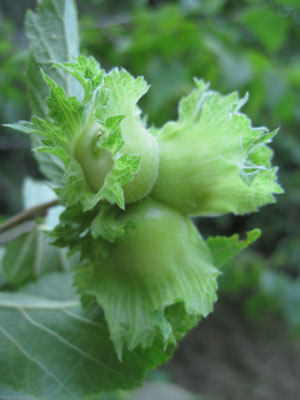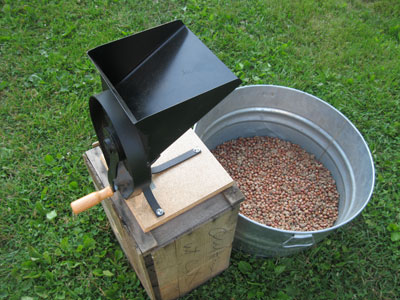 |
| American hazel (C. americana) grows well in Industry, Maine. Yaicha Cowell photo. |
By Will Bonsall
I’ve always loved filberts, those roundish nuts found in boxes of holiday mixes. They always tasted more substantial than the pecans and Brazil nuts, more evocative of northern forests.
In fact, those European types (Corylus avellana) aren’t very hardy here. Our native beaked hazelnuts (C. cornuta) are hardy, but their long, trumpet-shaped husks leave your hands feeling like you’ve been grabbing fiberglass insulation, and the tiny nuts are tedious to crack.
I greatly prefer the American hazel (C. americana). I live outside its native range, yet it seems perfectly adaptable here.
A word about name clarification: North American species are generally referred to as “hazels,” while Europeans are more commonly called “filberts,” or sometimes “cobnuts.” Some interspecific crosses, such as “filazels” or “hazelberts,” supposedly combine larger size with greater cold tolerance. Also, Americans and some of their crosses are not affected by Eastern filbert blight, a troublesome disease to which Europeans are susceptible. Breeding in Minnesota and elsewhere is further developing these. This research may have great usefulness for us in Maine. For now I am more than satisfied with the reliability of the Americans. They may have somewhat smaller kernels, but I find those kernels denser textured and richer in hazel flavor.
Selection and Propagation
That being said, C. americana varies greatly. I’ve been selecting seedlings for overall reliability, especially number of nuts per cluster. When I have them, they’re available from Fedco Trees.
American hazels have a strong habit of forming root suckers, which is useful for propagating a particular seedling with desirable traits. Because hazels, like most nuts, do not come very true to seed, you cannot “capture” desired genes by planting nuts; rather you must increase the plant asexually, as by root suckers from dormant plants.
Suckers are sprouts that shoot vertically from shallow lateral roots. You can expose the root (usually less than 3 inches deep) and clip it between the trunk and the sucker, giving you a new plant of the same clone. Of course the mother plant resents that root cutting, but typically many more roots are growing at different depths, and more are being made every year, so it won’t be missed for long.
Root suckers often lack fine roots (other than the single root from which they arise) to nourish them independently, but fine roots usually begin to form as soon as you replant that root sucker. I always snip off at least one-third of the shoot to encourage rootlet formation and to balance the above ground shoot with its now-reduced root system.
I assume one could easily graft scions of a select plant onto generic rootstocks, but since American hazels typically have several stems as opposed to a single trunk (like “tree hazels”), and since new suckers replace aging stems, I cannot see how one could keep straight what was grafted and what was a sucker.
Pruning and Not Fertilizing
Except for propagating new plants, suckers are kind of a nuisance. Left to its own tendencies, a hazel plant will turn into a bushy thicket, difficult to access for picking. I plant them about 8 feet apart within rows and 15 feet between rows. I try to keep mine cut back to four to six stems per plant. I do little or no other pruning, except removing occasional deadwood or tip pruning to encourage nut-bearing laterals.
One of the nicest things about most tree or shrub crops is their eco-efficiency, and hazel is no exception. It requires little input – especially fertilizer – in proportion to output – nuts. I’ve never added compost or purchased mineral supplements to my hazels. A couple of times in 30-plus years, I have added wood ash or maple leaves. The plants need potassium and calcium, but apparently are pretty good at scrounging those minerals from our soil. That soil contains abundant minerals that are not so readily available to annual crops, but hazels are much more resourceful.
I believe the maple leaves have been less important as a fertility source then as a mulch. Or perhaps they just remind the hazels of their natural habitat, the understory of well-drained climax hardwood forests. Given that ecological heritage, it would be clever to grow them as a companion to another, taller tree crop, such as burr oaks or chestnuts, or even apples; but, while hazels may thrive in the partial shade of tree crops (while benefiting from their leaf drop), they will not BEAR as well. In the wild their main role, like most plants, is merely to occupy the land, protect the soil, and enjoy life as they may. They need only enough sexual propagation to replace themselves, say one new plant every several decades; that doesn’t call for much nut production. They’re called into active duty only when some ecological emergency, say an uprooted tree or a logger, disrupts the canopy and allows in a flood of sunlight. Then the hazel knows exactly what to do: produce nuts.
So for maximum food production, keep hazels in perpetual emergency mode: Plant them in open sunlight. Or combine them with other food shrubs or trees, leaving generous aisles for sunlight. Hazel will tolerate lots of root competition, but not shade, at least if you want nuts.
 |
| The Davebilt is a good, simple machine for cracking nuts without mashing kernels. Yaicha Cowell photo. |
The long, thin catkins that form in autumn and hang through winter may hint at next year’s nut crop, but they are only part of the picture, and not the most important part, for those are the males – essential for production, but not themselves the product. Female flowers open in early spring and are bright red but much less conspicuous. Obviously they’re counting on wind and not insects for pollination. If you spot lots of those (and they’re hard to spot), prospects are good for a heavy crop – but things can still go wrong.
Pests
The only serious insect pest on my hazels is hazelnut curculio, but that is serious enough. This species of weevil can harbor in wild beaked hazels in nearby hedgerows and infest my cultivated nuts. Even if I could eliminate all the wild beaked hazels, I am loath to do so: They support many other wildlife species, including my hated enemies, the red squirrels – which I don’t wish to annihilate, but to come to terms with somehow.
I seem to get reasonable curculio control by diligently collecting and removing drops. I’m not sure how this works, because by then pupae in the aborted nuts should have hatched and flown off. Ripe-looking nuts that have a curc-hit scar but did not abort will have a full-size but empty nutshell. I don’t understand what’s happening, but I know that picking up all drops helps greatly to control the problem. Losses are usually well under 20 percent, which I find tolerable. I might get much better protection by spraying with something like Surround, but I’ve not tried that.
The next challenge comes from others who like to eat hazelnuts, notably squirrels and blue jays. Either can clean out an entire crop in a few days. Again the solution is vigilance. By mid-September, I watch nuts closely for signs of maturity, especially when the sticky green husks begin to brown at the edges. If I ignore what my eyes tell me, my ears will soon echo the same warning. Squirrels may be discreet in their predations, but birds are not; their brash corvine shrieks tell each other – and me – what they’re up to. If I’m wise, I drop everything else and pick the nut crop immediately. Every day means significant crop loss. Not that there aren’t plenty of other chores clamoring for attention at this season; it’s a matter of deciding what’s worth it.
Harvest
Indeed, the nuts are worth a great deal. Nutritionally they are high in vitamins E and B-complex, calcium, iron, copper, manganese, magnesium, zinc and selenium. They are 60 percent fat – an unsaturated, high-density lipid that reputedly helps the body deal with unfriendly fats.
Picking hazelnuts is pleasant. Most clusters can be picked from the ground, although a stepstool might help some people. I just bend the supple branches down to where I can reach them. Were it not for the pesky competition, I could let them get riper and shake most onto a tarp.
At this point the nuts are tightly enclosed in sticky husks. I spread the nuts indoors, 3 inches deep, on drying racks hung from the ceiling. That’s fine for a couple of bushels, but as production increases, I’ll need to find a way to increase curing capacity. The attic floor works as long as I can keep out squirrels.
After a week or two of this dry heat, the husks will all be brown and brittle. I then put the nuts in a galvanized washtub and tramp them with my heavy shod feet until they’re mostly separated into crunchy bits of husk and hard round nuts in their shiny brown shells. I winnow away most of the husk-chaff by repeatedly pouring it all from one 25-gallon bucket to another in a light breeze. Many nuts, especially smaller ones, will still be encased in husks, so I repeat the treading and winnowing until they are as clean as I can get them. Then I store them in cloth rice bags in steel, squirrel-proof barrels until I’m ready to proceed.
“Proceeding” used to mean cracking a small batch on demand with a hand nutcracker, but hand cracking a cup of nutmeats can easily take an hour. We think we have found a good, simple hand-crank machine, the Davebilt, for $150 from Davebilt, 410 Soda Bay Rd., Lakeport CA 95453. It generally cracks nuts without mashing kernels. The trick seems to be adjusting the gap by adding or removing washers (included with the machine). We get mostly whole and half kernels with little breakage. I believe we could improve the process greatly by first sorting unshelled nuts into two or more grades. I did some sorting with half-inch hardware cloth, but closer tweaking would help. Then we’d feed each batch through at its appropriate spacing.
The task remains of separating kernels from broken shells, which is slow (though nothing like cracking) but does not stop me from processing and eating all the hazelnuts I can grow, which is quite a lot. How I incorporate all those hazelnuts into my cuisine is another article.
About the author: Will Bonsall lives in Industry, Maine, where he directs Scatterseed Project, a seed saving enterprise. Check the Schedule of Events in this paper for his talks at the Common Ground Country Fair.
